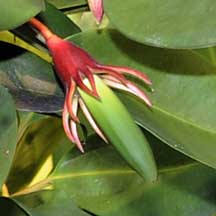 |
|
| plants text index | photo index |
| mangroves > Bruguiera in general |
| Tumu Bruguiera gymnorrhiza Family Rhizophoraceae updated Jan 2013 Where seen? This tree is sometimes seen in our mangroves, the bright red 'flowers' providing a splash of colour to the forest. According to Ng, it grows best on dry, well aerated soil towards the landward side but in Singapore, also found in mud. According to Hs uan Keng, it was common including at Jurong, Changi and Tuas. According to Tomlinson, it is a characteristic of the middle mangrove community and has been described as "the largest and probably the longest lived of the mangrove community". It has the broadest range of the genus and of all mangroves, from East Africa including Madagascar, Sri Lanka, the Malay peninsula, Micronesia and Polynesia to Ryu Kyu Islands and tropical Australia (Western Australia and Queensland). It was previously known as B. conjugata and is sometimes spelt Bruguiera gymnorhiza. Features: Tree to about 15m in Singapore, elsewhere to 30m or more. Bark dark grey or brown, rough, fissured in a regular chequered pattern with pimples (lenticels). With buttress and knee roots. Leaves eye-shaped (9-24cm long) leathery stiff glossy, sometimes reddish on the underside, arranged opposite one another. Stipules often reddish. One flower on each pendulous flower stalk, one flower per leaf angle. The flowers are large (2cm) with cup-shaped calyx that has 12-14 lobes. The calyx is bright red in the sun but may be pale or yellowish in the shade. Petals thin, pale orange and tipped with tassels. According to Tomlinson, the large flowers are pollinated by birds. The petals of the flower form a 'pouch' that holds loose pollen and are under tension. When probed at the base, the 'pouched' petal unzips to scatter a cloud of pollen over the head of the visiting bird. Propagule develops on the parent plant: not very long hypocotyl (15-25cm long), fat and cigar-shaped, slightly angular with a blunt tip. The tips of calyx lobes bend slightly towards the hypocotyl (not bent towards the stalk). According to the NParks Flora and Fauna website, the tree is the preferred local food plant for caterpillars of the moth Olene mendosa. Human uses: According to Burkill, tannin extracted from it is used to treat fishing lines as well as a black dye. The hypocotyls are eaten, after boiling and scraping the outer skin, "but not when there is anything better available". The bark is used to flavour raw fish, but "eating too much is dangerous". Leaves are also served raw as flavouring. Medicinal uses include the bark as an astrigent in diarrhoea and sometimes to treat malaria in Cambodia. According to Giersen, in Indonesia, a sweet meat is made out of the inner hypocotyl flesh plus sugar. The red timber is hard and used for heavy duty purposes such as foundation pilings, mine timbers, house posts. As well as furniture and cabinet work. Also as firewood and for making charcoal. |
 Erosion reveals buttess and knee roots. Lim Chu Kang, May 11  Buttress roots and knee roots. Lim Chu Kang, Apr 09  Large flowers, each on one stalk. Pulau Semakau, Jan 09 |
 Pulau Semakau, Jan 09 |
 Opened 'pouch' petals. |
 'Pouched' petals not yet open. Sungei Buloh Wetland Reserve, Mar 11 |
 Calyx may be yellow. Lim Chu Kang, Apr 09 |
 Tassels on petal tips. Chek Jawa, May 09 |
 Sepals bend towards the propagule. Pasir Ris Park, Aug 09 |
| Tumu on Singapore shores |
| Photos of Tumu for free download from wildsingapore flickr |
| Distribution in Singapore on this wildsingapore flickr map |
|
Links
References
|
|
|